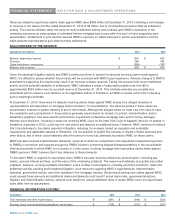GE 2014 Annual Report Download - page 162
Download and view the complete annual report
Please find page 162 of the 2014 GE annual report below. You can navigate through the pages in the report by either clicking on the pages listed below, or by using the keyword search tool below to find specific information within the annual report.
142 GE 2014 FORM 10-K
FINANCIAL STATEMENTS PRESENTATION & POLICIES
Experience is not available for new products; therefore, while we are developing that experience, we set loss allowances
based on our experience with the most closely analogous products in our portfolio.
Our loss mitigation strategy intends to minimize economic loss and, at times, can result in rate reductions, principal
forgiveness, extensions, forbearance or other actions, which may cause the related loan to be classified as a TDR.
We utilize certain loan modification programs for borrowers experiencing temporary financial difficulties in our Consumer loan
portfolio. These loan modification programs are primarily concentrated in our non-U.S. residential mortgage and non-U.S.
installment and revolving portfolios and include short-term (three months or less) interest rate reductions and payment
deferrals, which were not part of the terms of the original contract. We sold our U.S. residential mortgage business in 2007
and, as such, do not participate in the U.S. government-sponsored mortgage modification programs.
Our allowance for losses on financing receivables on these modified consumer loans is determined based upon a formulaic
approach that estimates the probable losses inherent in the portfolio based upon statistical analyses of the portfolio. Data
related to redefault experience is also considered in our overall reserve adequacy review. Once the loan has been modified, it
returns to current status (re-aged) only after receipt of at least three consecutive minimum monthly payments or the equivalent
cumulative amount, subject to a re-aging limitation of once a year, or twice in a five-year period in accordance with the Federal
Financial Institutions Examination Council guidelines on Uniform Retail Credit Classification and Account Management policy
issued in June 2000. We believe that the allowance for losses would not be materially different had we not re-aged these
accounts.
For commercial loans, we evaluate changes in terms and conditions to determine whether those changes meet the criteria for
classification as a TDR on a loan-by-loan basis. In CLL, these changes primarily include: changes to covenants, short-term
payment deferrals and maturity extensions. For these changes, we receive economic consideration, including additional fees
and/or increased interest rates, and evaluate them under our normal underwriting standards and criteria. Changes to Real
Estateǯs loans primarily include maturity extensions, principal payment acceleration, changes to collateral terms, and cash
sweeps, which are in addition to, or sometimes in lieu of, fees and rate increases. The determination of whether these
changes to the terms and conditions of our commercial loans meet the TDR criteria includes our consideration of all of the
relevant facts and circumstances. When the borrower is experiencing financial difficulty, we carefully evaluate these changes
to determine whether they meet the form of a concession. In these circumstances, if the change is deemed to be a
concession, we classify the loan as a TDR.
When we repossess collateral in satisfaction of a loan, we write down the receivable against the allowance for losses.
Repossessed collateral is included in the caption “All other assets” in the Statement of Financial Position and carried at the
lower of cost or estimated fair value less costs to sell.
For Consumer loans, we write off unsecured closed-end installment loans when they are 120 days contractually past due and
unsecured open-ended revolving loans at 180 days contractually past due. We write down consumer loans secured by
collateral other than residential real estate when such loans are 120 days past due. Consumer loans secured by residential
real estate (both revolving and closed-end loans) are written down to the fair value of collateral, less costs to sell, no later than
when they become 180 days past due. Unsecured consumer loans in bankruptcy are written off within 60 days of notification
of filing by the bankruptcy court or within contractual write-off periods, whichever occurs earlier.
























